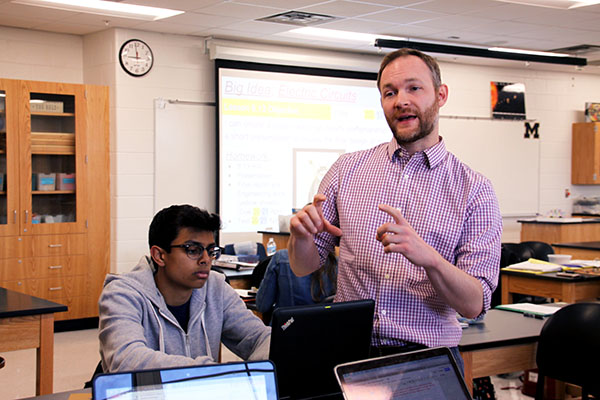Teachers describe differences, share memories, between CPS, District 225

It’s electric: Advising his students on how to successfully complete their electrical circuit art projects, Science Teacher Jordan Pasqualin seeks to help students foster creativity using their knowledge of physics. According to Pasqualin, he taught with CPS before coming to GBS, and at both he wanted his students to gain information from his class to take into the real world. Photo by Cassidy Foronda
April 21, 2017
With every city, school and environment comes a new culture and experience. Some teachers at South have had the opportunity to teach students at Chicago Public Schools (CPS) and experience the differences in both districts.
Science Teacher Laura Jane Elgass taught at a military academy in the CPS network. Elgass said she grew up in the area of the academy and it was her goal to begin her teaching career in CPS.
“I was at a school where 85 percent of the students were low income,” Elgass said. “That brings a very different perspective. There is huge value in having that perspective as well, [and working with] students with a completely different set of advantages.”
According to Elgass, working at a military academy comes with a pre-established stigma that she did not agree with in reflecting on her time working there.
“I was at a military academy so it was a different environment and it was actually selective enrollment and [had] generally really well behaved kids,” Elgass said. “Sometimes people think if it’s a military academy that your job is [to be] a big disciplinarian, and it was not that kind of a school.”
According to Elgass, she wanted to teach more physics than other sciences. She said she wasn’t able to focus primarily on physics at the academy because the science department was so small; it consisted of four teachers. Elgass explained she came to South because there was a position that opened which allowed her to teach more physics.
“I was in a small school, and when you’re at a small school you often have to teach [more than one subject], so I was teaching more chemistry than I was teaching physics, and my primary goal was to teach physics,” Elgass said.
Science Teacher Jordan Pasqualin also has experience teaching with CPS at Jones College Prep, a high school with selective enrollment.
“Although academically strong, students still had a variety of personal lives and personal issues, ranging from no issues to socio-economic issues related to income and poverty,” Pasqualin said. “There’s lots of different students in both [CPS and District 225] systems. There are unique opportunities and challenges in working in both, so it’s hard to compare.”
Pasqualin said that initially, a neighbor of his told him about a position at South, but it was his appreciation of the resources, opportunities, support, and positive atmosphere that made him decide to teach here.
“The one thing that I like that happens frequently at GBS, is that students have a lot of opportunity to explore their passions, academically and non-academically, both within and outside the school day,” Pasqualin said. “I think that’s valuable for every student, and I think that would be nice to see [that] students have more opportunities in every setting, CPS included.”
History teacher Kelly O’Toole said she had a different experience with CPS. O’Toole taught at George Westinghouse College Prep, and while she explained how she had a great experience at her first teaching job, there were still some obstacles she had to face.
“I left CPS because of the state of the district,” O’Toole said. “I already went out on strike during my second year and didn’t want to go through the stress of that again. It was very hard leaving the students and staff.”
O’Toole explained that her favorite thing about the school was the students. According to O’Toole, working with her students for two years allowed them to establish a close relationship.
“The students were wonderful and had a great sense of humor,” O’Toole said. “They were very grateful of their education because I taught at a selective enrollment.”
Even though O’Toole faced stressors in her job with CPS, she was able to reflect on a moment in which she felt fulfillment and pride.
“I’ll never forget the moment when one of my students, who came from a very turbulent and difficult home life, even at one point was homeless, and didn’t have any parents, ran into my class and told me he got a full ride to the University of Chicago,” O’Toole said. “He was one of the most resilient students I have ever taught in my life. I was so proud of him.”
Pasqualin has had many different experiences with students, both here at South and at CPS, and he says they brought valuable lessons about teaching.
“The biggest lesson I’ve learned about teaching [is that] content in classes is valuable, but sometimes what’s more valuable is that students are leaving your classroom with larger skills to be successful later on in life,” Pasqualin said.


